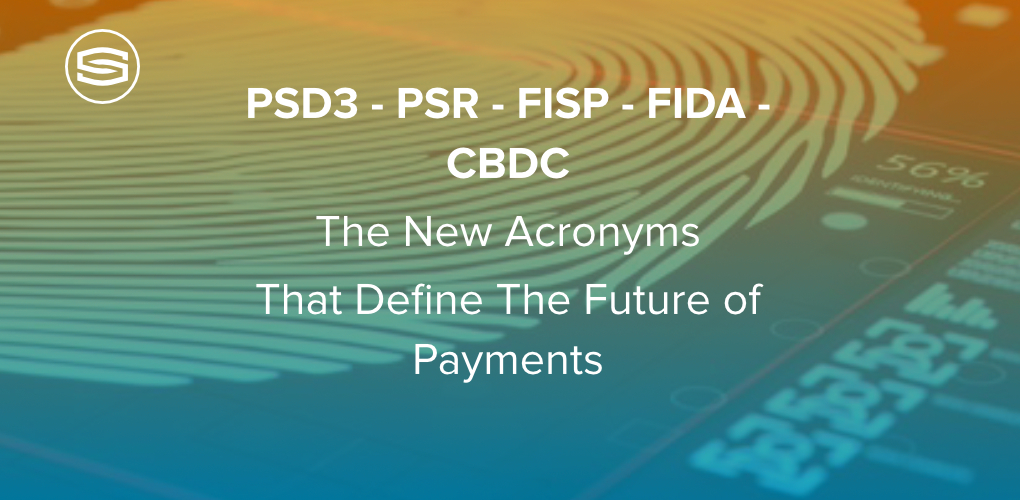
Insights & Opinions
PSD3 - PSR - FISP - FIDA - CBDC The New Acronyms That Define The Future of Payments
Wed, 05 Jul 2023


On June 29, we held the last virtual round table before summer to evaluate the new publications of the European Commission (EC) for the payments industry. The publications on June 28 are fundamental in the future development of Europe's thriving payments industry.
After digesting PSD and PSD2, it is now time for a PSD3, a PSR (Payments Services Regulation) and the Open Finance Framework, with the introduction of Financial Services Information Providers (FSIP) and Financial Data Access (FIDA). Last but not least, June 28 2023, will be remembered for the Regulation on the Establishment of the Digital Euro Package (Central Bank Digital Currency, CBDC).
Likely I'm missing a few acronyms in the article, but the ones mentioned in here were the most important ones (correct me if I'm wrong). So get ready during summer for a new event season with many new acronyms you didn't hear before.
Essentially, the idea of the virtual round table a day later, on June 29, was to highlight a couple of elements as a guideline for a deeper study of these documents in the coming weeks and months. I will use this blog to share my personal takeaways from the quick reading of the documents, the comments online and the discussion we had with 20 other experts during The Banking Scene Breakout Bites.
From PSD2 to PSD3 and PSR
PSD3 will not just be an upgrade, an improvement of PSD2, it will be a new Directive that finds its foundation in both PSD2 and the e-Money Directive. This way, PSD3 becomes the set of guidelines for anything related to licensing and what it means to be a licensed Payment Institution or an e-Money Institution (EMI). This is the document to read concerning the authorisation and supervision of PIs and EMIs, but interestingly also a couple of measures to ensure sufficientfinancial inclusion.
To reduce the fragmentation across Europe, the commission decided to bundle the rest in a Payment Services Regulation to avoid the transposition process and interpretation into national law.
The PSR will define the rules to act as a Payments Services Provider (PSP). These rules come with an update on the Regulatory Technical Standards for Strong Customer Authentication and Common and Secure Open Standards for Communication. All this should improve customer rights and reduce the risk of fraud.
An interesting novelty is, for example, the requirement for AISPs to provide their own authentication to the user after 180 days and the requirement to think about financial inclusion for individuals with a disability and older people.
Inspired by the Instant Payments Regulation, the PSR also talks about an obligation of an IBAN-nam check for every SEPA credit transfer.
FISP and the Framework for Financial Data Access
Financial Information Services Providers (FISP) are a new species in the wonderful world of open banking. Like AISP and PISP under PSD2, FISPs are regulated third parties that should get access to a wide range of data related to financial products and services, through a required technical interface, as part of Financial Data Sharing Schemes.
Indeed, the Open Finance Framework will be scheme based, including a business model providing a fair value distribution across the ecosystem. This should ensure a higher buy-in from all stakeholders involved to speed up innovation, also in closed markets like pension savings. Interestingly, the regulator is talking about transaction-related data and sustainability-related data and input data to evaluate, for example, the creditworthiness of companies.
The European Commission believes that this will improve customer experience and lead to more innovation and higher competition. Think of, for example, accelerated through more convenient comparison websites that could soon instantly ask for the required data and lead the customer to the best possible deal in the same process.
The Consent Dashboard
In 2019, we had a presentation at The Banking Scene Conference Brussels by Esther Stegman, back then working at De Volksbank (you can still find the speech on Chris Skinner's website), where she proudly shared that the bank was developing a dashboard where their customer could manage the consents that consumers had given to IASPs and PISPs through PSD2.
That was a revolutionary approach and, in theory, not even allowed. However, the Dutch Central Bank made an exception, on the condition that there was an instant notification to the respective TPP of that withdrawal. Although that was a show-stopper for many banks, it inspired the European Central Bank to add it to the new PSD3 and the Open Finance Framework to improve consumer protection.
I reckon not all Fintechs like it, but I believe it is a big improvement. If open banking succeeds one day, and consumers share data with many organisations, this dashboard is the only way to keep a view on the consents you gave and manage them.
CBDC, the Digital Euro
The fans of the digital euro were absent in our session. Let me use this quote to describe the sentiment of our audience in relation to the digital euro: "It's pretty cynical to simultaneously provide a legal framework for the digital euro while setting up a new regulation with measures to preserve the physical euro".
When I quickly read the framework, I also had the idea that it was written to make an exact digital version of what exists on paper, and I am not sure that is the right approach for a successful digital euro.
Will an extra digital wallet help those that are digitally excluded? Will people that don’t know how to bank mobile, understand how to use this new wallet solution? Will an extra digital wallet preserve the level of privacy that increasingly fewer consumers are looking for? Will a digital euro that is not programmable have sufficient selling propositions to compete with other monetary solutions like what we have today? Is an obligation to accept payments with a digital euro wallet enough to drive usage effectively?
All that remains to be seen.
Conclusion
I like the evolution in respect of PSD3, PSR and also the open finance framework, as I believe this may lead to a new wave of innovation in the financial services industry. The digital euro though, remains blurry for me. I will need many more debates and talk, and perhaps some results from POCs in de future to better estimate its chances for success.
One thing is clear: we need to get accustomed a new set of acronyms that shape the future of payments and finance if we want to be perceived as true thought leaders and opinion makers.